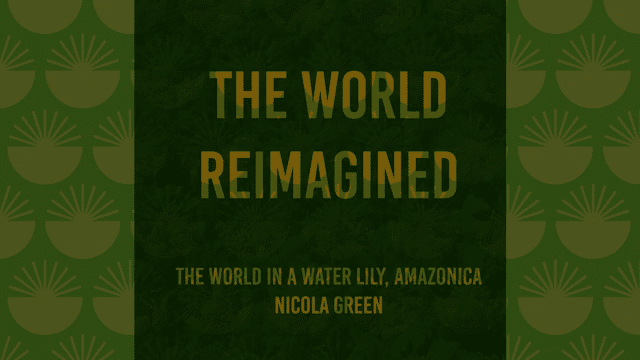I am really honoured to be part of The World Reimagined - a ground-breaking, national art education project designed to transform how we understand the Transatlantic Trade in Enslaved Africans and its impact on all of us.
As a Principal Artist, I was asked to choose a theme and create an artwork using a large fibreglass globe as my canvas. It’s one of hundreds of sculptures installed in different trails all across the country. Viewers are encouraged to follow the trails and go on a journey of discovery, with each piece telling a different part of the story. Within the Camden and Westminster trail, my globe is installed in the magnificent grounds of Westminster Abbey. It is the final step in the journey, exploring our potential to Reimagine the Future.
I wanted to write about the themes, ideas and symbolism contained in my piece The World in a Water Lily, Amazonica.
My globe represents the deep-rooted connection between racial justice and climate justice - two of the most urgent and important issues of the twenty-first century.
It is widely accepted that the Anthropocene epoch is inextricable from colonial expansion and slavery, that there is an intrinsic connection between the oppression of people and the exploitation and plunder of the world’s natural resources. Historically, colonialism exacerbated climate change, and enduring forms of imperialism mean that environmental racism remains pervasive today. Whilst climate change affects everyone all over the world, racially marginalised groups disproportionately bear the brunt of environmental degradation. It is projected that the Global South will incur 75-80% of the cost of climate change despite contributing the least carbon emissions. In many ways, the climate emergency is colonialism’s natural conclusion.
The Guiana Shield
The centre of my globe is enveloped by the Guiana Shield, one of the largest remaining intact rainforests on earth. It represents a symbol of hope; we are all blessed with an opportunity to preserve these remaining 'lungs' of the earth. The forest is a protective sanctuary, a literal shield, between heaven and earth, it is the difference between life and death. It also symbolises nature at the centre of our world, reflecting indigenous and traditional belief about the divinity of the ecosystem, the interconnectedness of all species, and our duty to protect the planet.
To create this, I have embellished drone photography of the Guyanese rainforest; of ancient evergreen Greenheart, Wallaba, Purpleheart, Apok and Silk Cotton trees. I have used pearlescent acrylic and diamond dust in verdant emeralds and lush veridians to capture the density and vibrancy of the forest.
Heaven
Above the rainforest, atop my globe, the sky is bursting with black and brown angels. Throughout history, cherubs have almost exclusively been depicted as white, so much so, that whiteness became tantamount to holiness and the sacred. Over the centuries the association of heaven with whiteness became intertwined with supremacy, colonialism, and nationalism. To me, this really reveals the importance and pervasiveness of the stories we tell about ourselves, the ways the visual image plays such a vital role in how we understand the world around us, and that we infer so much about how our society values people from these depictions.
I have reimagined idyllic pastoral scenes and grandiose depictions of putti from the canon of Western art. I wanted to reclaim the magic of what heaven looks like to me, to challenge prevailing depictions of paradise and the whitewashing of renditions of the divine. The cherubs are digitised versions of my original paintings, the detail of the fabrics is hand-painted, and the wings are embellished with 24k gold leaf.
In many ways, this is a joyous image, it embodies hope, and represents how faith can provide strength in the face of adversity. However, it is also a memorial. The middle passage is the final resting place of at least 1.8 million African people, so these angels are a commemoration of the unmarked lives lost during the trans-Atlantic slave trade.
The Sea
The bottom of the globe is inspired by a historic mappa mundi The World in a Cloverleaf created by the protestant pastor and cartographer Heinrich Bünting in 1581. Although this image might look superficially inaccurate, it is from a time when maps were schematic and didactic, designed to tell a story rather than for navigation or to reflect the arbitrary carving out of territories.
I was drawn to the idea of the land as petals because it roots the shared story of our planet back into nature. I chose to transform this, to include all the world’s continents, and to reshape the cloverleaf into a water lily, the national flower of Guyana, symbolic of unity and rebirth.
The sea and land are hand-painted interpretations of the original wood block print map. The ship that can be seen setting for sail for the New World in Bünting’s map has been recreated in vinyl. Bünting grew up during the age of discovery, a turning point in world history in which seafaring enabled the onset of European colonial expansion and the slave trade.
I hope my globe will be a symbol of hope, a reminder that we have a chance to reimagine a better future for our children and grandchildren. We have the opportunity to protect the Guiana Shield and all the wonderful secrets it holds but we must act now to change the course of climate change, and tackle the pervasive inequality in our society. We need to acknowledge that injustice is not consigned to history but lingers in the present. As we work together to recognise our shared history of the transatlantic trade in enslaved africans, I hope that by embracing our history, we can understand our present. This will allow us to truly grasp the possibilities of our future.























